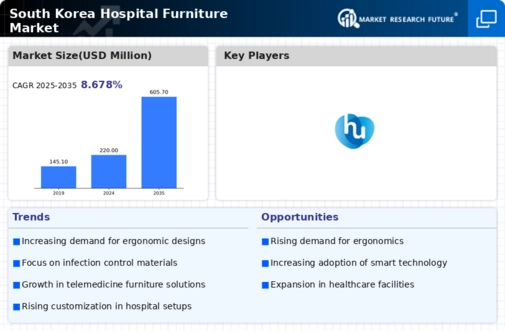Aging Population
The demographic shift towards an aging population in South Korea significantly influences the hospital furniture market. By 2025, it is estimated that over 20% of the population will be aged 65 and older, necessitating specialized furniture that caters to the needs of elderly patients. This demographic trend indicates a growing demand for hospital furniture that provides comfort, accessibility, and safety. Hospitals may invest in adjustable beds, mobility aids, and other supportive furniture to accommodate this population. As a result, the hospital furniture market is likely to expand, driven by the need for tailored solutions that enhance the quality of care for older patients.
Rising Healthcare Expenditure
The increasing healthcare expenditure in South Korea is a pivotal driver for the hospital furniture market. As the government allocates more funds towards healthcare, hospitals are likely to invest in modern furniture to enhance patient care and comfort. In 2025, healthcare spending is projected to reach approximately 9.5% of GDP, indicating a robust growth trajectory. This financial commitment suggests that hospitals will prioritize upgrading their facilities, including furniture, to meet the evolving needs of patients and healthcare professionals. Consequently, the hospital furniture market is expected to experience a surge in demand as hospitals seek to create more efficient and patient-friendly environments.
Government Regulations and Standards
Government regulations and standards play a significant role in shaping the hospital furniture market. In South Korea, regulatory bodies are establishing guidelines that dictate the quality and safety of hospital furniture. Compliance with these regulations is essential for manufacturers and healthcare providers alike. As hospitals strive to meet these standards, they are likely to invest in high-quality, compliant furniture that ensures patient safety and comfort. This regulatory environment suggests that the hospital furniture market will experience growth as manufacturers innovate to meet the evolving standards set forth by the government, ultimately enhancing the overall quality of healthcare facilities.
Increased Focus on Infection Control
The heightened focus on infection control in healthcare settings is a critical driver for the hospital furniture market. In South Korea, hospitals are increasingly adopting furniture made from antimicrobial materials and easy-to-clean surfaces to minimize the risk of hospital-acquired infections. This trend is likely to continue as healthcare facilities prioritize patient safety and hygiene. By 2025, it is anticipated that the demand for infection-resistant furniture will rise, prompting manufacturers to innovate and provide solutions that meet these stringent requirements. Consequently, the hospital furniture market is expected to adapt to these needs, fostering growth in this segment.
Technological Advancements in Healthcare
Technological advancements in healthcare are reshaping the hospital furniture market. Innovations such as smart beds, integrated monitoring systems, and telehealth capabilities are becoming increasingly prevalent in hospital settings. These advancements not only improve patient outcomes but also enhance operational efficiency. In 2025, the integration of technology in hospital furniture is expected to grow, with hospitals investing in furniture that supports these innovations. This trend suggests that the hospital furniture market will see a shift towards multifunctional and technologically equipped furniture, aligning with the broader goals of improving healthcare delivery and patient satisfaction.












Leave a Comment